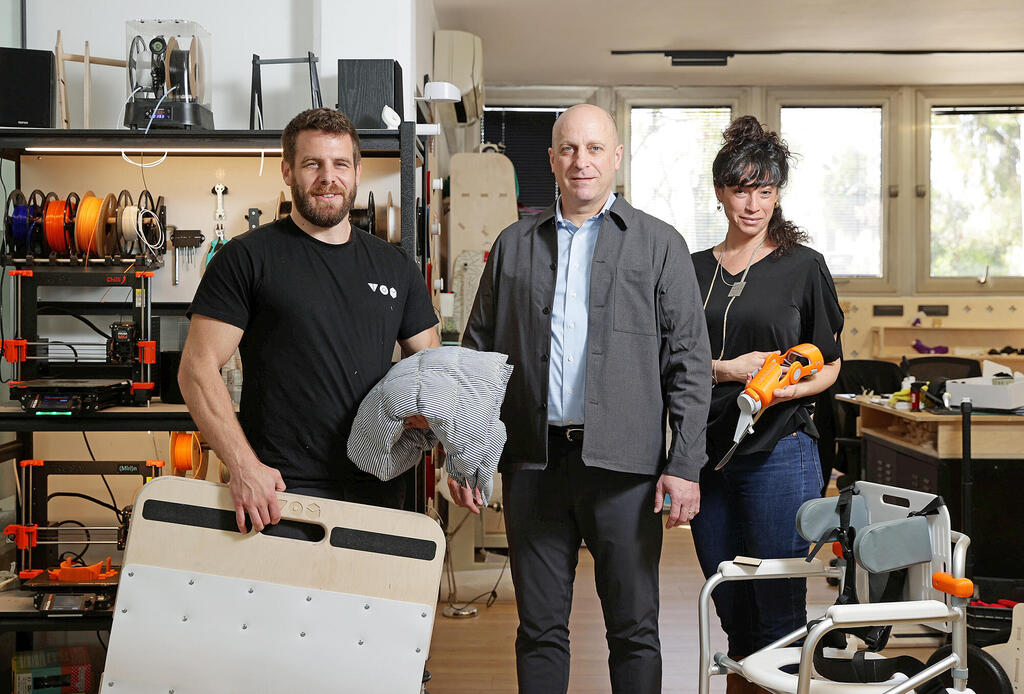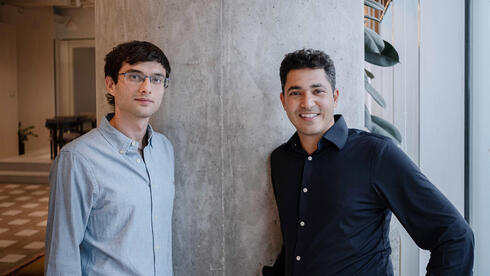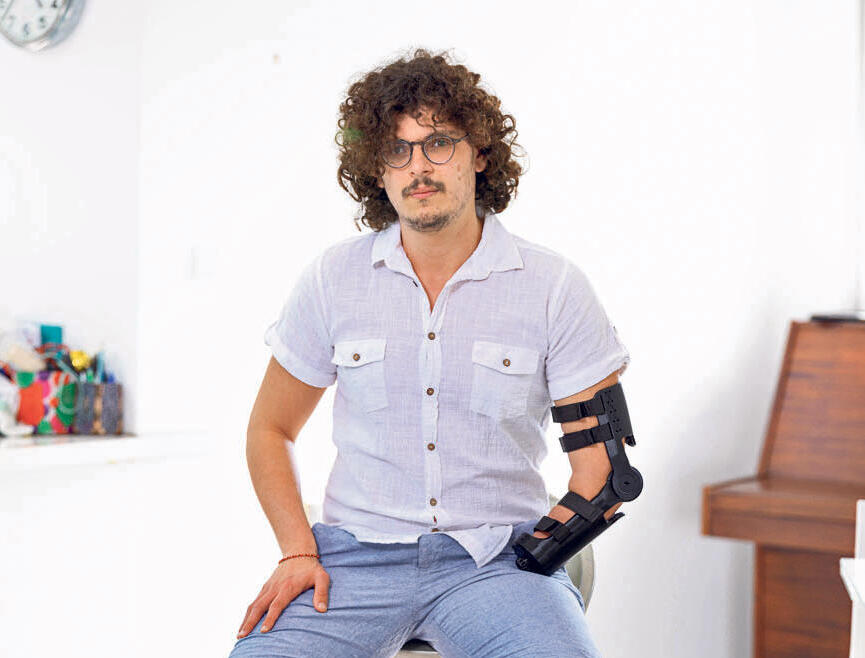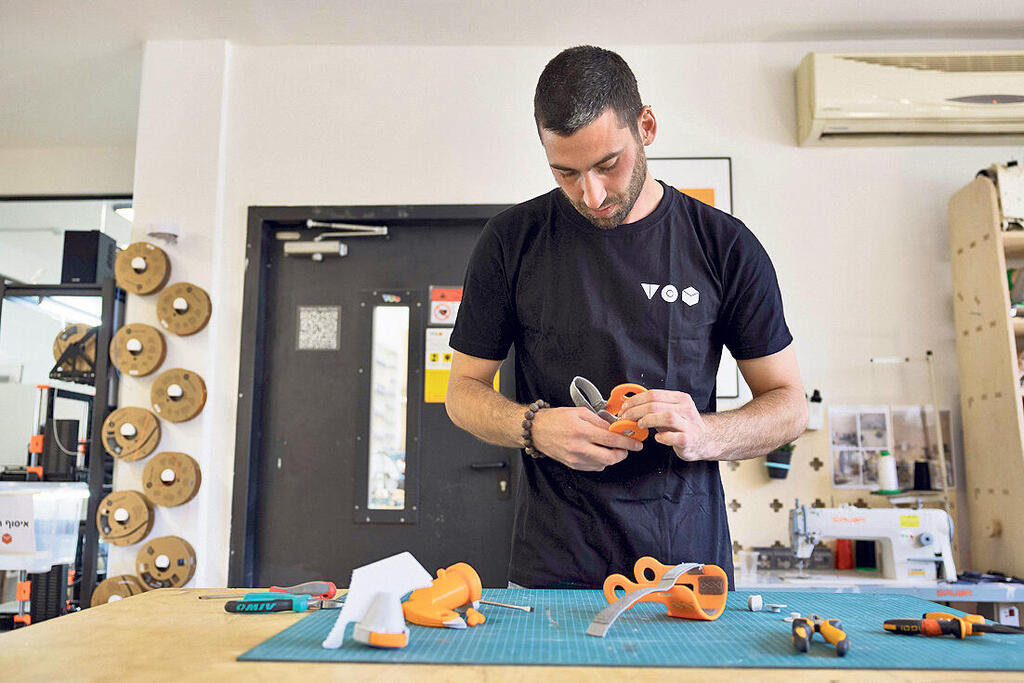
Empowering Makers: Inside the TOM workshops reshaping lives
Unique prosthetics for war casualties, therapeutic blankets for Nova Festival survivors and a portable toilet seat for evacuated residents. A team of talented and principled geeks got together at TOM (Tikkun Olam Makers) in order to develop, 3D print and distribute free products for people with disabilities that commercial companies have no interest in developing.
Just a few steps away from Kaplan St. in Tel Aviv, among auto shops, small workshops and a giant parking lot, is a place where huge 3D printers produce odd plastic components with a never-ending hum. These are the workspaces of TOM (Tikkun Olam Makers), an Israeli venture that seeks to help people with disabilities by developing unique solutions that the market does not provide. Industrial designer Ahuvia Hanneman stands beside one such 3D printer, working on creating a better version for a prosthesis used by amputees.
Hanneman (30) first learned of TOM’s activities from his lecturer and he was immediately taken in by the exceptional social venture. He says that, even as a child, he would assemble carts from random junk and build shelves and structures that required creativity, a strong technical sense and good hands. In the army too, as a camouflage instructor in an elite unit, he worked with his hands, building dedicated posts and meshes to improve soldiers’ immersion in the field. When the war erupted and Hanneman was not called to reserves, he sought another way to contribute to society and found it in the venture’s workshops.
3 View gallery


Dana Yichye Shwachman (from right), Gidi Gristein and Roy Goldenberg.
(Photo: Orel Cohen)
“One of the challenges faced by makers (people who independently invent and produce 3D objects using technological means – YA) is access to a location, to tools and equipment”, he explains. “Many makers will not do carpentry work at home because if they live in a condominium the neighbors would object. At TOM, it is possible. The activity here has a great deal of meaning.
“For me, the activity here is like being on a playground. There is good interpersonal communication with other makers, we all help each other, and once we successfully develop something, we share in the elation. The understanding that I am doing something that helps someone else, makes me feel good. Sometimes you don’t have to reinvent the wheel, not everyone has to create the next ChatGPT. You can do something small that makes a big difference for someone else”.
“Everything’s online”
TOM is an Israeli and global venture founded about a decade ago by Reut Institute, a non-profit engaged in social and economic issues, striving to “ensure the robustness and prosperity of Israel and the Jewish people”. The venture consists of volunteer activities worldwide, including programmers, designers and engineers who develop products intended to improve everyday functions for people with disabilities -products that commercial companies have no interest in developing as they lack a large enough market.
The venture’s headquarters are in Israel and New York and its activity relies on private donations and fund grants. TOM CEO, Edun Sela, says that the venture maintains ties with dozens of campuses and universities around the world, aiming to generate ideas that will become accessible products, free for all. These products enable an amputee to cut a salad or slice bread, a parent on crutches to push a baby stroller, a girl born without a hand to play the guitar, and a soldier with an affixed arm to play poker with his friends in the rehabilitation ward.
The portfolio of solutions developed in TOM workshops to date consists of some 50 products and aids, and there are dozens more in advanced stages of development. Among others, they developed or produced prostheses with interchangeable heads with assorted unique functionalities, therapeutic blankets for treating post trauma, a Mobility Trainer for toddlers with disabilities and a pen holder for people who have difficulty folding their fingers. The products that have achieved their goal and were found useful among the users, are offered free on the internet, as open source, in English, to benefit people with disabilities anywhere around the world.
Each product and its aim is described online in simple language, along with a list of raw materials required to produce it, the online stores where the components can be purchased and their prices. Each such list comes with instructional clips intended to simplify production by “DIY”ers or makers who will make the product for them. The team that Hanneman works with, for example, has already uploaded a portfolio of about ten solutions for upper limb amputees, integrated within a lightweight multipurpose prosthesis, significantly less expensive than those produced by commercial companies and available to all, using a domestic 3D printer.
TOM Founder and President, Gidi Gristein, who founded Reut Institute and was among the founders of the Birthright Project, explains that the venture was born of the understanding that many people have trouble finding products that they need due to their distant location or high price. “Reut’s activity involves visiting the periphery quite a bit. When in Safed, I discovered how difficult it is for residents to access services and products, forcing them to travel to Haifa to get them, while there is an Ort High School in Safed that can provide the infrastructure for closing some of those gaps.
“I asked myself why people who live next to the high school have to go all the way to Haifa to get something they can get from local makers. That’s where the idea for TOM came from. Our model is to lower the price to the end users by 80-99%, providing them identical access. Identical access means that, if Halutza is the remotest part of Israel, then its access to our services will be identical to that at Tel HaShomer, as everything is online and in open source, and the raw materials are accessible too”.
“Some of the prostheses are nonsense”
TOM’s makers call the multipurpose prostheses that they print “Pajama Prostheses”. They are interim prostheses meant to serve upper limb amputees until they are fit with permanent prostheses that are costly and which require extensive measurements and adjustments that may take months. After arm amputees get their permanent prosthesis, the one that the makers provided is meant to become a spare, the kind that you switch to at home and you want to reduce physical stress without surrendering your functionality.
The first “Pajama Prostheses” were printed in TOM’s workshop in 2017. Since then, they were improved based on user satisfaction and specific needs that were raised. Their simplicity and the fact that they are multipurpose, renders them an attractive product among arm amputees, mainly as they can be simply adjusted with the turn of a screw. They have replaceable heads connected to a fork, knife or spoon, and there are others that come with a guitar pick or broad plastic surface enabling a better grasp of a ball, for people whose arm was amputated but still want to shoot baskets.
One of the first users of this modular prosthesis is Noam Guez (25) an electrical engineering student from Be’er Sheva. Guez lost his left hand to a grenade that exploded while he was in basic training. He has been in touch with the makers since his first prosthesis was fit, sharing with them his insights and experiences, raising new needs, while they think of what to do and suggest solutions. The secondary gain of their communication is a growing database of solutions that will serve many others like Guez, who don’t intend to let the disability forced upon them to disrupt their plans.
“In the first year, every amputee sees the electronic prosthesis that is on the market and is excited by the cool and innovative technology, the moving fingers, thinking that it’s the most amazing thing they’ve ever seen”, says Guez. “It is only later that they understand that they were too naïve and that the electronic prostheses are nonsense and that they do not hold water”.
Why nonsense?
“I’m speaking for myself, of course, not for all the amputees around the world. I have a friend or two who are pleased and satisfied with their electronic prosthesis, but I also know another 15 who are not. My experience with it was one of discomfort, heaviness and operating difficulties, against their added value of an aesthetic and attractive appearance. Arm amputees believe, truly but incorrectly, that they can do everything with that prosthesis, and it’s true – but the pain that goes with it is not worth it”.
What do you mean?
“Arm amputees are forced to apply excess pressure on their healthy hand, and it works ten times harder. This subjects all of the joints to an immense load. From the fingers, the wrist, forearm, elbow, arm to the shoulder. The result is acute, ongoing pain, constantly increasing. That is the most problematic part of amputations, the invisible part. People tend to think that a prosthesis only solves the problem of lost functionality, but it has a much more important role - to enable balance and reduce the pressure to the healthy arm. The electronic prosthesis is heavy and uncomfortable. Imagine constantly carrying another 1.5 or 2 Kg with you. It’s a lot”.
Guez received his electronic prosthesis relatively quickly, six months after he was injured by the grenade. Nevertheless, he did not pass up a friendly and convenient solution and he joined the TOM project to develop a simple and lightweight prosthesis to serve him on everyday occasions. “The stump constantly changes during the first year and there is a great deal of work relating to measuring and adjusting a prosthesis, which is very expensive. A printed prosthesis costs several hundred NIS, it is very light and, most importantly, it allows amputees to resume activities almost immediately without losing functionality, and to replace it easily, based on changes in stump dimensions”.
“IDF’s improvement center”
TOM operations sharply increased when the war in Gaza erupted and hundreds of Israelis came to the workshops to invent, develop and produce quick solutions for the casualties and evacuees. “We shifted to emergency mode, all of the teams shifted to a mode of action focused on providing aid to the war zones”, Grinstein recalls. “Where we focused on developing solutions until then, we now shifted to accelerated production. We put the pedal to the metal and started producing about 1,000 products and solutions for the end users”.
“In the initial days of the war, we were the IDF’s “improvement center”, military representatives came here to prepare accessories they needed for the ground maneuver. Soldiers of elite engineering units came here to print components intended to improve drone capabilities. The state’s services collapsed and the void was filled by civilians. We are merely a cog in this huge array of the civil front”.
The challenges that the war introduced to people with disabilities led the makers to develop solutions to needs dictated by the circumstances. Head of TOM Operations in Israel, Roy Goldenberg, talks about developing foldable ramps that make it easier for people on wheelchairs to enter secured spaces while avoiding the obstacles on the way. In another case, creative makers adjusted a set of wheels to a TV chair, enabling it to be rapidly moved to the secured space instead of moving the person on it to a wheelchair when the siren goes off.
For children and youths with disabilities, evacuated from their homes due to the war, TOM’s makers developed dedicated toilet seats. “They had accessible restrooms in their homes, but they have been staying at hotels or guesthouses for a while and no one should hold a boy with CP in the restroom”, explains the venture’s chief designer, Dana Yichye Shwachman. “We already had a model for a seat that could be adjusted to various sizes and we just accelerated production. Thus far, we have provided ~70 such seats to evacuated families”.
Shwachman’s father used a wheelchair and it is perhaps her personal history that led her to develop products for people with disabilities. “I truly believe that people who live with a disability are not limited”, she emphasizes. “We, as a society, limit them. Therefore, I greatly believe in what we are doing. I consider design to be a tool for social equality, providing tools that eventually transform the lives of many and improve their everyday life”.
“People fought for the blankets”
Shaked Lev, an occupational therapist at the Ichilov Rehabilitation Department, turned to TOM after noticing that her young patients have trouble falling asleep at night and waking up for therapy in the morning. She recalled that many medical centers use special therapeutic blankets to relieve anxiety and pressure among mental health patients, children with ADD and people on the autistic spectrum, and thought that they would help her patients too.
The blankets, called weighted blankets, have small pockets containing polymer or ceramic pellets. Considering the manner in which the pockets are sewn into the blankets and their weight compared to the patients’ body weight, the blankets apply moderate pressure to the body and create a sense of safety that relieves stress, anxiety and pain. “One of the most prominent problems among the casualties of October 7th is sleeping, caused by disquiet and anxiety”, Lev explains. “They’ve gone through a lot, it is impossible not to understand them. The problem is that it was difficult to wake them up for therapy in the morning and those who did get up, had trouble cooperating. Their moods were bad too”.
Lev wanted to see if the makers could produce the blankets and they agreed. TOM obtained the fabric, the polymer were donated by Poliram, a plastics manufacturer from Moshav Ram On. “One of my patients, injured on October 7th, could not fall asleep at night”, says Lev. “He never woke up for therapy. At best, he woke up at noon. When the first weighted blankets arrived, I gave him one and he woke up fresh the next morning. He said it was the first time since the injury that he managed to sleep through the night”.
Another one of Lev’s patients is Matan Fishman (30), a reservist from Kibbutz Tel Itzhak, injured in Gaza. A 10m concrete wall weighing several tons collapsed on him just before his force was supposed to return to Israel and his right leg was shattered. The surgery and pressure chamber treatments ensured that he would not need an amputation, but the neurological pain has not gone away since then.
Before the injury, Fishman didn’t know there was such a thing as a weighted blanket. When Lev first told him about it, he couldn’t understand why people would agree to take on more weight when all they want to do is rest. Despite his skepticism regarding their effectiveness, he cooperated and was given a blanket that weighs 8 Kg. “I tried the blanket and liked it. It helps me fall asleep and stay asleep”, he says.
Like many other soldiers injured in Gaza, he too hopes to make a full recovery, if only to return to his unit. There might be a war in Lebanon, they may have to go back to Gaza, no one knows. When that happens, he wants to be there. Except that there is a huge gap between his desire to resume routine and the challenges of rehabilitation. “The rehabilitative process is like a roller coaster”, he says. “Some days I feel completely healthy, ask myself what I’m doing here, and some days I feel so much pain and every step is impossible”.
“I quickly realized that these blankets are the most popular topic in the ward and among the most desirable products. Patients started sharing them, in some cases they even fought over them”, says Lev. Patient satisfaction in the rehabilitation ward generated a demand for weighted blankets and TOM’s makers initiated accelerated production processes, aided by dozens of seamstresses and tailors nationwide. Thus far, they have sewn over 1,000 blankets, and they are still working on more.
The path to the perfect weighted blanket required learning and quite a bit of trial and error. “At first, contact between the sewing machine needle and pellets crushed them. The sewing itself is not easy, as the blankets are heavy, but the more we made, we improved”, says Dr. Assaf Krebs, a designer and artist who heads TOM’s content methodology department while teaching at Shenkar College and the Tel Aviv University School of Architecture.
Krebs adds that, a few days ago, he gave “nine weighted blankets to Nova survivors, who use them for therapeutic yoga. We provided a few dozen to the Natal organization for trauma victims, which intends to distribute it to its patients and we have concurrently prepared to sew many more blankets at Kibbutzim College and a school of mental health patients in Hadera. I recently saw a girl there screaming with joy after she managed to sew a proper weighted blanket herself ”.
Krebs considers TOM’s activity as the “embodiment of the Scandinavian and post-capitalist models when one community reaches out to help another in a manner that strengthens and empowers everyone involved. Clearly, we could have raised money, bought a large quantity of weighted blankets from China at low prices and meet the entire demand, but that is not part of our agenda. We believe in creating community circles that perform Tikkun Olam. Think of the empowerment that it provides students with emotional disabilities, knowing they are making a significant contribution to society”.
“We’re not easy to digest”
Ronit Mark (65) of Ramat Gan, retired from her position in cyber security about a decade ago and when she heard about the 3D printers she enrolled in a course to see what everyone was talking about. “I spoke to the people at TOM when the war began and they referred me to Kibbutzim College where they sewed the weighted blankets. I don’t know how many we’ve sewn since then. We sat and sewed for hours. Many were sent to the Nova survivors. I later sewed accessories for one of TOM’s main products for children with disabilities, the “Galgalush”, she says.
The ‘Galgalush’ or “Toddler Mobility Trainer” as it is officially known, is an inexpensive and simple wheelchair intended for children under 3 and can be independently assembled. Before it was developed, many disabled toddlers had trouble with mobility due to the high price of adjusted wheelchairs and their shortage in Israel. “Wheelchairs for toddlers are hardly ever covered by insurance, they cost around $2,500 and are usually unavailable in Israel. The ‘Galgalush’ costs 500 NIS. Thus far, we have distributed about 200 and no one has paid for them because somehow the price is always donated by someone”, says Grinstein.
According to him, the low price and the ease of attaining the ‘Galgalushes’ create among the users’ parents a sense of plenty. “An average family will have trouble spending 10K NIS on a wheelchair for a child who will grow out of it in a year or two”, he says. With the ‘Galgalush’, they shift to a mindset of having three – one at home, one with the grandparents and one at school”.
When Grinstein looks to the future, he envisions a simple workshop with basic tools available in almost every high school in Israel, rendering it a regional maker center. People in need of a solution will come and high school makers will know how to solve their issues. “One day, it will be built into vocational education in Israel. We are not easy to digest, we’re here to change the world, but I have no doubt that one day, people will understand what we’re doing”, he says.
















